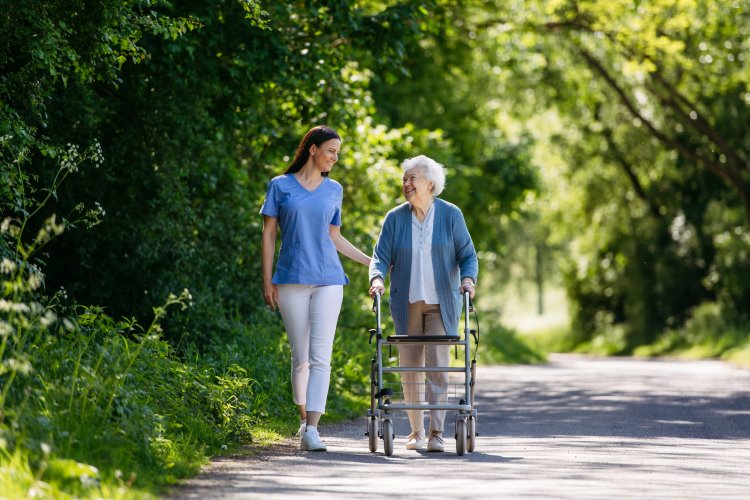Frequent Falls & Interventions for Dementia Patients

Falls are a significant public health concern, causing millions of injuries among older adults each year. For those living with dementia, the risk of falls is nearly double that of their peers without dementia, with fall rates approaching 50%. These falls often lead to serious injuries, such as fractures, which can result in hospitalization and long-term care admissions requiring orthopedic rehabilitation.
To address this heightened risk, it is crucial to implement targeted interventions that focus on specific risk factors for falling. Recent research from Drexel University’s College of Nursing and Health Professions highlights the importance of considering not only health and functional factors but also environmental influences in fall-risk screening and prevention strategies. By doing so, we can develop more effective measures to safeguard the well-being of this vulnerable population while minimizing the risk of a fall and any secondary injury. 1
Connection Between Dementia and Falls
Understanding the link between dementia and falls is crucial for developing effective prevention strategies. Cognitive impairments in dementia patients significantly impact their mobility, leading to physical weakness, gait changes, and poor balance. These factors heighten the risk of falls, a problem worsened by medications commonly prescribed for dementia. Additionally, drugs used to manage comorbidities such as high blood pressure, diabetes, urinary incontinence, pain, and psychiatric conditions can further increase the likelihood of falls.
Additionally, behavioral changes and disorientation associated with dementia, such as difficulties with judgment, sensory perception, and communication, contribute to a higher risk of falling. 2,3
Risk Factors for Falls with Dementia
Here is a further breakdown of the risk factors that contribute to falls.
Mobility Issues
Physical weakness, gait changes, poor balance, and arthritis are a leading cause of falls for dementia patients, especially when wandering. Maintaining physical activity is crucial for individuals with mobility issues, as it can help mitigate the associated balance and muscle strength problems. Regular exercise not only supports overall mobility but can also enhance daily functioning and cognitive health. 2,4
Vision/ Spatial Issues
Vision and spatial issues are common in dementia, affecting how individuals perceive and process visual information. This can lead to difficulties in spotting hazards and safely navigating their environment, increasing the risk of falls. Regular vision checks are essential, as both dementia and age-related eye conditions can impair sight and contribute to these challenges. 2,4
Mental Issues
Mental issues such as pain, boredom, and loneliness can significantly increase the risk of falls in individuals with dementia. Since they may struggle to express discomfort verbally, it’s important to look for non-verbal cues of pain and address them promptly. Engaging activities and social interaction can alleviate boredom and loneliness, reducing the likelihood of restless wandering and improving overall mood and quality of life. 2,4
Personal Care
Addressing personal care needs such as hunger, thirst, and the need to use the bathroom can help prevent falls in individuals with dementia. Ensuring they have regular access to food and drinks, as well as timely assistance to the bathroom, reduces the likelihood of them attempting to get up on their own and risking a fall. 2
Memory Impairment & Confusion
Memory impairment and confusion, common in Alzheimer’s Disease, can make preventing falls increasingly challenging. Individuals may forget they need assistance to walk safely, leading them to attempt walking independently despite the risk. Additionally, poor judgment can result in unsafe decisions, such as navigating stairs or icy paths alone, further increasing the likelihood of falls. 2
Medication Side Effects
Medications used to treat dementia symptoms, such as antipsychotics, benzodiazepines, and antidepressants, can increase the risk of falls by causing drowsiness, dizziness, and drops in blood pressure upon standing. It is important for individuals experiencing these side effects to consult their GP promptly to manage these risks effectively. 2,4
Environment
Clutter and excessive items can create obstacles, increasing the risk of tripping and falling. Additionally, poor lighting and lack of clear signage can further exacerbate the risk by making it difficult for individuals to see and identify hazards, ultimately contributing to a higher likelihood of accidents. 2,4
Fall Interventions for Dementia Patients
The challenges above highlight the necessity of tailored interventions that address both the cognitive and physical aspects of dementia to prevent falls and improve the overall quality of life for those affected.
Environmental Modifications
Adjusting the home environment is crucial in preventing falls. This includes removing clutter to avoid tripping hazards and ensuring adequate lighting to enhance visibility. Installing grab rails, improving floor stability, and using contrasting colors for better visibility of objects can also make a significant difference.
Use of Assistive Devices
Assistive devices like walkers and handrails provide essential support and stability. They help individuals with dementia maintain balance and navigate their environment more safely, reducing the risk of falls.
Use of Emergency Devices
Personal falls alarms, often worn around the neck, can alert family members or emergency services if a fall occurs. Additionally, voice-activated devices like Alexa or Siri can be programmed to call for help if needed, and having a phone and emergency supplies readily accessible can provide crucial assistance in case of a fall.
Supervision and Assistance with Daily Activities
Regular supervision and assistance with daily activities can help manage fall risks. This includes support with mobility and ensuring safety during tasks such as getting up from a chair or using the bathroom.
Strength Training and Balance Therapy
Engaging in strength training and balance therapy can improve overall stability and help reduce falls. Physiotherapists and occupational therapists can provide targeted exercises and interventions to enhance muscle strength and coordination.
Regular Checkups
Regular checkups are essential for maintaining safety and preventing falls. This includes reviewing medications to manage side effects and conducting vision and hearing tests to address sensory impairments that may contribute to a greater risk of falls. Regular assessments can help ensure that any changes in health are promptly addressed and managed. 3
By understanding the various contributors to falls and implementing effective prevention strategies—such as environmental modifications, the use of assistive devices, and regular health checkups—families and caregivers can significantly reduce the risk of falls. It’s important to recognize that a recent fall is a strong predictor of future falls. Families should discuss this with a physician, including risk evaluation, management, and prevention strategies, ideally with a primary care physician or geriatrician. Developing a strategic plan can help minimize the risk and secondary consequences of falls, ultimately enhancing safety, independence, and quality of life for people with dementia.
References
[1] “Fall Rate Nearly 50% among Older Americans with Dementia.” Drexel Home, 12 Jan. 2023, drexel.edu/news/archive/2023/January/Fall-Rate-Nearly-50-Percent-Among-Older-Americans-with-Dementia.
[2] Heerema, MSW, Esther. “Understanding Why People with Dementia Fall Can Help Reduce the Problem.” Verywell Health, Verywell Health, 21 Apr. 2022, www.verywellhealth.com/causes-of-falls-in-people-with-dementia-98558.
[3] “Dementia and Falls.” Dementia UK, 16 Apr. 2024, www.dementiauk.org/information-and-support/health-advice/dementia-and-falls/.
[4] “Falls and Dementia.” NHS Inform, 18 June 2024, www.nhsinform.scot/healthy-living/preventing-falls/falls-and-dementia/.
The information provided in the article is for general informational purposes only. This information is not a substitute for medical advice. Accordingly, before taking any actions based upon such information, you are encouraged to consult with the appropriate professionals.



